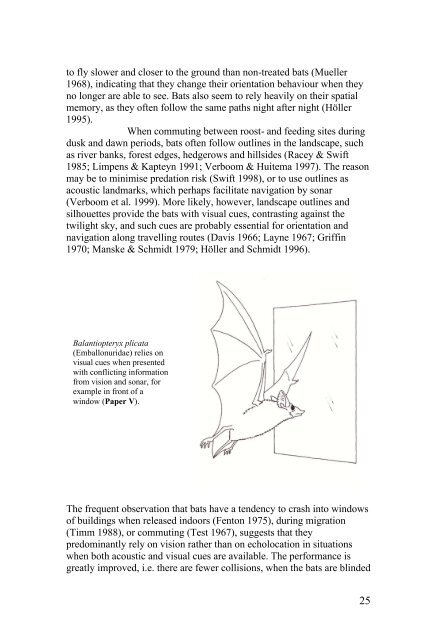Vision in echolocating bats - Fladdermus.net
Vision in echolocating bats - Fladdermus.net
Vision in echolocating bats - Fladdermus.net
Create successful ePaper yourself
Turn your PDF publications into a flip-book with our unique Google optimized e-Paper software.
to fly slower and closer to the ground than non-treated <strong>bats</strong> (Mueller<br />
1968), <strong>in</strong>dicat<strong>in</strong>g that they change their orientation behaviour when they<br />
no longer are able to see. Bats also seem to rely heavily on their spatial<br />
memory, as they often follow the same paths night after night (Höller<br />
1995).<br />
When commut<strong>in</strong>g between roost- and feed<strong>in</strong>g sites dur<strong>in</strong>g<br />
dusk and dawn periods, <strong>bats</strong> often follow outl<strong>in</strong>es <strong>in</strong> the landscape, such<br />
as river banks, forest edges, hedgerows and hillsides (Racey & Swift<br />
1985; Limpens & Kapteyn 1991; Verboom & Huitema 1997). The reason<br />
may be to m<strong>in</strong>imise predation risk (Swift 1998), or to use outl<strong>in</strong>es as<br />
acoustic landmarks, which perhaps facilitate navigation by sonar<br />
(Verboom et al. 1999). More likely, however, landscape outl<strong>in</strong>es and<br />
silhouettes provide the <strong>bats</strong> with visual cues, contrast<strong>in</strong>g aga<strong>in</strong>st the<br />
twilight sky, and such cues are probably essential for orientation and<br />
navigation along travell<strong>in</strong>g routes (Davis 1966; Layne 1967; Griff<strong>in</strong><br />
1970; Manske & Schmidt 1979; Höller and Schmidt 1996).<br />
Balantiopteryx plicata<br />
(Emballonuridae) relies on<br />
visual cues when presented<br />
with conflict<strong>in</strong>g <strong>in</strong>formation<br />
from vision and sonar, for<br />
example <strong>in</strong> front of a<br />
w<strong>in</strong>dow (Paper V).<br />
The frequent observation that <strong>bats</strong> have a tendency to crash <strong>in</strong>to w<strong>in</strong>dows<br />
of build<strong>in</strong>gs when released <strong>in</strong>doors (Fenton 1975), dur<strong>in</strong>g migration<br />
(Timm 1988), or commut<strong>in</strong>g (Test 1967), suggests that they<br />
predom<strong>in</strong>antly rely on vision rather than on echolocation <strong>in</strong> situations<br />
when both acoustic and visual cues are available. The performance is<br />
greatly improved, i.e. there are fewer collisions, when the <strong>bats</strong> are bl<strong>in</strong>ded<br />
25


